Clematis Polish Spirit - growing conditions
Clematis Polish Spirit, bred in the 90s by Polish breeder Stefan Franczak, belongs to the vigorous shrub vines. The main advantages of the culture are good frost resistance, high decorative effect and abundant flowering. Consider the characteristics of the variety, the rules for planting and leaving.
- Description of the variety
- Landing rules
- Timing
- Place and soil
- Preparation of seedlings
- Landing technology
- Care features
- Watering
- Loosening and mulching
- Top dressing
- Garter
- Pruning
- Preparing for winter
- Reproduction methods
- Layers
- By dividing the rhizome
- Diseases and pests
- Wilt (wilting)
- Rust
- Powdery mildew
- Aphid
- Spider mite
- Nematode
- Medvedka
- Slugs
- Garden decoration methods
- Testimonials
- Useful videos
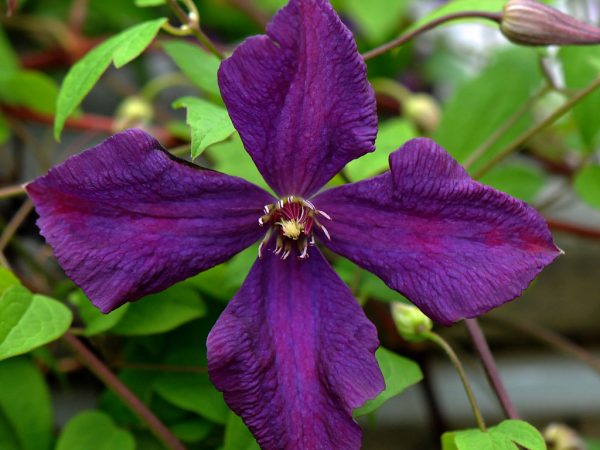
Сlematis polish spirit
Description of the variety
The botanical name is clematis polish spirit. A perennial plant has good frost resistance (zone 4-9), easily tolerates a decrease to -34 ° C.
The variety is resistant to adverse weather conditions and sudden temperature changes. Therefore, it is suitable for growing almost throughout the entire territory of our country.
External features:
- curly liana with hard stems of dark brown color, length - 3-4 m;
- crown diameter - 1-1.2 m;
- inflorescences are large - with a circumference of 9-10 cm, ink-purple, consist of 4-5 petals;
- deep red stamens;
- long flowering - lasts from June to October;
- after its completion, seeds are formed about 8 mm in length;
- leaves of an emerald tone, oval or lanceolate with a pointed tip;
- the root system is well developed, branched, superficial.
Landing rules
Regardless of the cultivation area, the key to successful growth and abundant flowering will be a correctly selected place for planting, an optimal soil composition and high-quality material.
Timing
You can plant seedlings at any time of the year - from spring to autumn, but it is better to do this from mid-April to the second decade of May. At this time, the soil will warm up well, and the outdoor temperature will reach 14-16 ° C. In such conditions, clematis will quickly take root and grow.
When grown in tropical and subtropical climates, autumn planting of seedlings is allowed - until the end of September. 2 months before the upcoming cold weather, the seedlings will have time to release new roots and prepare for wintering.
Place and soil
The light-loving large-flowered liana prefers to grow in a place well-lit by the sun; it also develops well in light shading. Better to plant in an area where there is shade at lunchtime. This can be the south, east and west side of the garden.
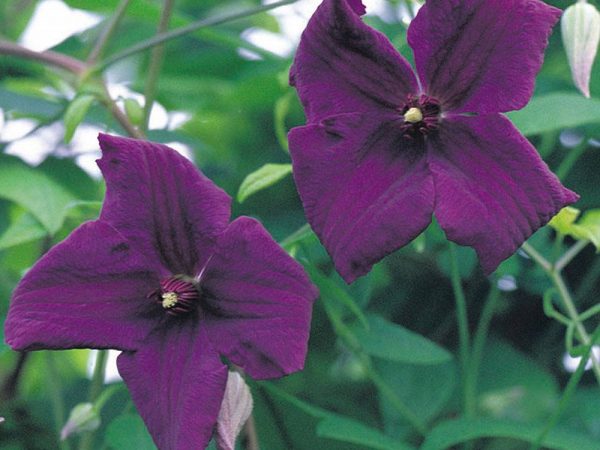
Polish spirit clematis
When grown in the northern part, the plant will not receive enough light, as a result, flowering will be poor, and the leaves will turn pale.
Loose, well-drained soil with neutral levels of acidity and alkali is suitable. If the site is acidified, it is necessary to add a deoxidizer - 400 g of chalk, slaked lime or dolomite flour per 1 m².
It should be planted on loam or sandy loam. In the first case, 20 kg of sand, vermiculite, perlite are introduced per 1 m². When planting on sandy loam soil, add a couple of buckets of clay.
Choose a location free of strong winds and swamps. The optimum depth of groundwater passage is 2 m. It is better to plant it on a hill, as this reduces the risk of waterlogging and rotting of the root system.
Preparation of seedlings
If you want a beautiful shrub with all the varietal qualities, go shopping at a horticultural nursery.
The best planting material is considered to be seedlings with closed roots (with an earthen ball or in a plastic container).
Choose mature bushes with several branches, densely covered with foliage. They have a well-developed root system, so they will safely transfer the planting to the site.
Criteria for choosing a quality material:
- the stems are flexible, without breaks, outgrowths and mold;
- leaves and buds of a rich green color, do not contain dry fragments, holes, black and yellow spots;
- when shaking off the crown, the leaves do not crumble.
Before planting, clematis is kept in a cool room at a temperature of 2 ° C for two days. Then they are removed from the pot and soaked for a couple of hours in cold water, the roots are cut to 2-3 cm in length. This is necessary so that after planting, the plant begins to intensively grow new shoots.
Landing technology
Considering the large size of the crown in adult specimens, young seedlings are planted at a distance of at least 1.2 m. So they will fully develop without creating competition for moisture, space and nutrients.
The pits are prepared in advance so that the embedded components have time to settle. Approximate parameters - 50x60 cm.
10 cm of drainage is poured into each hole - pebbles, crushed stone or brick chips. Half the volume is filled with fertile soil mixture - 5 kg of humus and peat are mixed, 300 g of turf ash, 100 g of superphosphate and 80 g of potassium sulfate are added.
The soil is trampled down, a hole is pulled out in the center, a rhizome is placed in it, all voids are filled up, tamped, watered with warm water. Consumption per bush - 20 liters. To prevent rapid evaporation of moisture, sprinkle the trunk circle with a thick layer of peat, humus or leaf compost.
If you are planting a grown seedling 2-3 years old with lignified branches, it is necessary to deepen the root collar by 10-12 cm. This will stimulate the development of a large number of new stems in the lower part, as a result the crown will be thick and dense. When planting a young specimen with green shoots, this part of the bush must be left on the surface of the soil.
Care features
In the first two weeks, the seedlings can quickly burn in the sun and dry out, in order to prevent this, at lunchtime they are shaded with burlap or agrofibre.
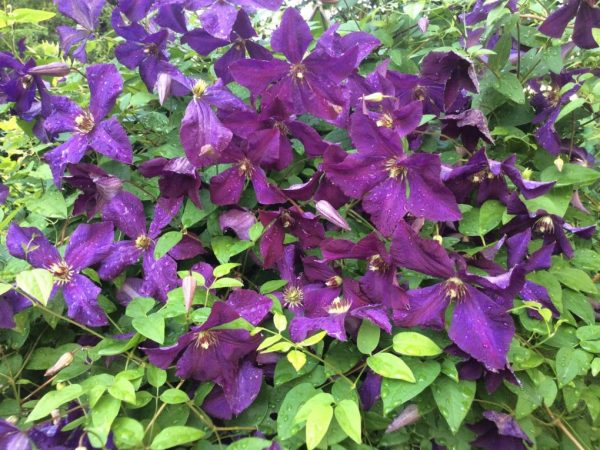
Clematis polish spirit description
Further, standard care is required, the same as for other varieties of clematis.
Watering
Throughout the month, young bushes moisturize every other day to stimulate rapid rooting. Further watering is carried out as the soil dries up to a depth of 5-6 cm, provided that the summer is dry. Usually the frequency is twice a week.
With regular precipitation, moisture is not required, since the roots of the vine will rot from excess moisture and it may die.
Adult shrubs, which have a massive crown and bloom luxuriantly, moisturize according to the following scheme:
- in early spring until bud break;
- at the stage of budding;
- after flowering;
- in late autumn, when the shrub leaves the foliage.
On hot days, clematis is irrigated with warm water. It washes away dust, protects the crown from the appearance of pests and wilting. The procedure is carried out in the evening when the sun goes down.
Loosening and mulching
After moistening, it is necessary to loosen the soil so that it passes moisture and oxygen well. You should also regularly remove unwanted vegetation in your garden, which is an excellent breeding ground for infections and parasites.
After watering, a mulching layer of peat, compost or sawdust is applied - they protect the soil from rapid drying out and prevent the growth of weeds.
Top dressing
In the first two years, clematis does not need food, since they have enough nutrients laid down during planting.
After this time, the bushes are fed several times per season:
- In early spring, in order to stimulate the intensive growth of the root system and young growth, nitrogen-containing preparations are introduced. Watered with a solution of urea, nitrophoska or nitroammophoska. Dissolve 15 g of the substance in a bucket of water.
- To improve the quality and long-term flowering, they are fed with potassium sulfate - 1 tbsp. l. for 10 liters of water.
- After the buds dry out, to restore strength, the shrub is fed with a liquid superphosphate solution (15 g per bucket of water).
- In autumn, when the liana has shed all the leaves, leaf compost or last year's manure can be embedded in the trunk circle - 10 kg / m².
To prevent the occurrence of burns on the roots and to speed up the process of assimilation of trace elements, top dressing of clematis is combined with abundant watering.
Garter
The first time they tie it up immediately after landing to any support - an arch, trellis, pergola or a specially constructed structure near the walls of a house or other building. Tying is necessary several times per season as the shoots grow. So the stems will grow in the right direction, and the crown will have a beautiful and compact appearance.
It is important that the support is stable and can support the weight of dense and heavy green mass. Tied up with a thin rope or twine.
Pruning
The plant belongs to the 3rd group of pruning (strong), therefore it needs a cardinal haircut.
Clematis Polish Spirit has buds on the stems of the current season, old lignified branches do not bloom. Therefore, before wintering, they are completely cut off, leaving hemp 10-15 cm long with 1-2 buds. With the arrival of spring, new shoots will begin to grow from the remaining eyes.
For young seedlings, a standard pruning scheme is used - they leave one of the strongest stem, pinch it at a height of 30-35 cm, so that in the future it begins to intensively build up lateral processes.
During the period of active growth, cut out branches that have been broken off, dried up, damaged by diseases and pests. Yellowed foliage is also removed. At the peak of decorativeness, dried buds are cut to extend the flowering period and stimulate the blooming of new flowers.
All manipulations are carried out using a sharp and sterile pruning shears, scissors. After pruning, the shrub is irrigated with a fungicide - this prevents infection with infections and pests.
Preparing for winter
Clematis can freeze at an early age. A week before the first autumn frosts, the trunk circle is spud with a thick layer of peat, humus or sawdust.
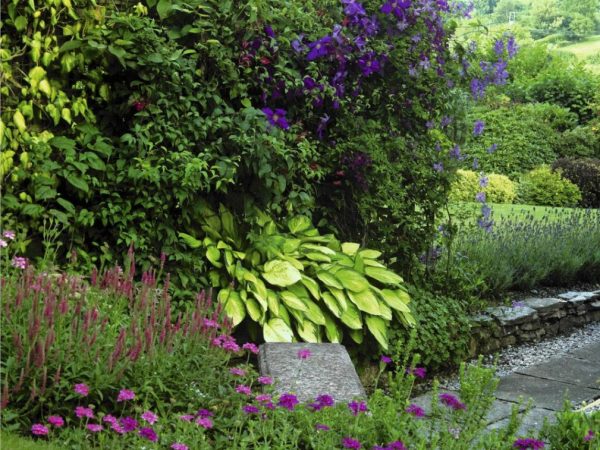
Clematis polish spirit description and photo
The hemp remaining after cutting is sprinkled with fallen leaves, then covered with spruce branches, a wooden box or cardboard box is placed on top.
Reproduction methods
This decorative perennial can be propagated in two ways - by stem layering and by dividing the rhizome. Both methods give good results if all the rules for planting and caring for seedlings are followed.
Layers
In the fall, when the vine sheds the leaves, they choose a flexible, lignified twig on it, which is closest to the ground.
A groove is pulled out nearby, the shoot is lowered into it in a horizontal position, fixed with pins or brackets. Fall asleep with a mixture of humus, peat and sand, mixed in equal amounts. Sprinkle with warm water.
On the eve of the first frost, the layers are sprinkled with fallen leaves or sawdust, spruce branches are laid on top.
In the spring, when the snow melts and the heat of the street stabilizes, the branch is dug up, separated from the bush, and cut into pieces. For successful rooting, each section must have roots.
Delenki are seated separately according to the same principle as purchased clematis.
By dividing the rhizome
This method is advisable for old plants that need to be rejuvenated or shrubs with damaged roots.
Clematis is watered abundantly, after an hour, when the soil gets wet, dug out, dipped in water to wash off the rest of the soil.
The dried root system is cut into pieces with a shovel or knife to get several sections with roots, one shoot and buds. Places of cuts are sprinkled with crushed coal, then planted in a flower garden or in a garden.
Diseases and pests
This perennial vine is rarely invaded by pests and diseases. But if the rules of planting, care and maintenance are violated, it can easily get sick and die.
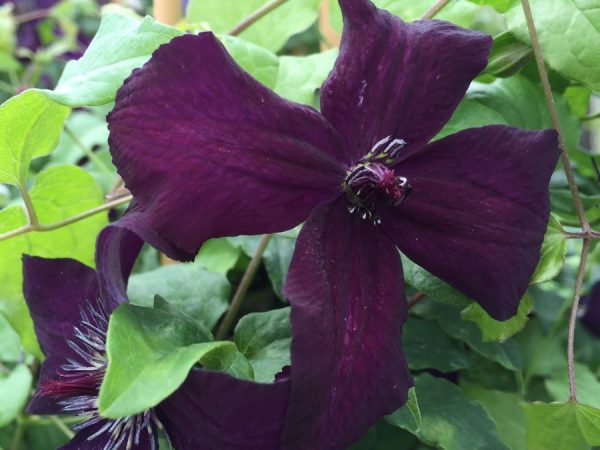
Clematis large-flowered polish spirit
Wilt (wilting)
Sharp wilting is the main symptom of this sore. Usually appears in hot and dry weather.
It is impossible to cure a diseased plant, so it is dug up and burned. The place of growth is spilled with Fundazol or a raspberry solution of potassium permanganate.
Rust
Rusty bloom on the stems of leaves in the form of outgrowths leads to massive leaf fall and suspension of growth and flowering of the shrub.
First you need to cut out the diseased areas, then treat the crown with Ridomil gold or Bordeaux liquid.
Powdery mildew
A whitish, oily bloom on the shoots, leaves and inflorescences indicates the defeat of this fungal infection. All damaged organs are removed on the crown, then sprayed with Topaz, Skor, Hom or Karatan.
Aphid
A dangerous insect that settles in colonies on the underside of the leaves. It multiplies quickly and in a short time causes the drying out and death of the decorative liana.
It feeds on the sap of foliage, which leads to its curling, yellowing and falling off.
The plant requires immediate treatment, since these parasites leave behind a sugar coating - an ideal environment for the appearance of a sooty fungus.
At the initial stage of infection, you can use folk remedies - ash and soap solution, tobacco, onion or garlic infusion.
The neglected form is treated with pesticides - Karbofos, Fitoverma or Akarin.
Spider mite
In conditions of extreme heat and drought, clematis is susceptible to the invasion of this insect. The tick braids the underside of the leaves with a small cobweb, sucking the juices out of them. The affected leaves first turn yellow, then become covered with a marble pattern.
In the fight against it, acaricides are used - Actellik or Aktara. To avoid reappearance, the crown is regularly irrigated with warm water, on hot days every evening.
Nematode
Damages the root system, clogs blood vessels and blocks access to moisture, oxygen and nutrients. As a result, the crown begins to wither and dry out.
It is difficult to save a plant infected with this parasite, so it is dug up, disposed of, and the place of growth is spilled with a solution of copper sulfate.
Medvedka
Gnaws roots, making numerous moves in the soil. Simple measures will help to cope with this pest:
Early in the morning, heaps of manure are laid out in the near-trunk zone, in which the insect likes to parasitize. The next day, the bear that has accumulated in them is collected and burned.
Dig several bottles or cans of beer into the ground at an angle of 45 ° so that the parasite can get into it.
Spill the holes in the ground with vegetable oil.
Slugs
They feed on leaf tissues, which leads to a loss of decorativeness of the shrub. In the fight, special pesticides are used - Slug-Eater or Thunderstorm. To protect against their appearance, the trunk circle is sprinkled with wood ash or coniferous sawdust.
Garden decoration methods
This culture is very popular in both industrial and private landscaping:
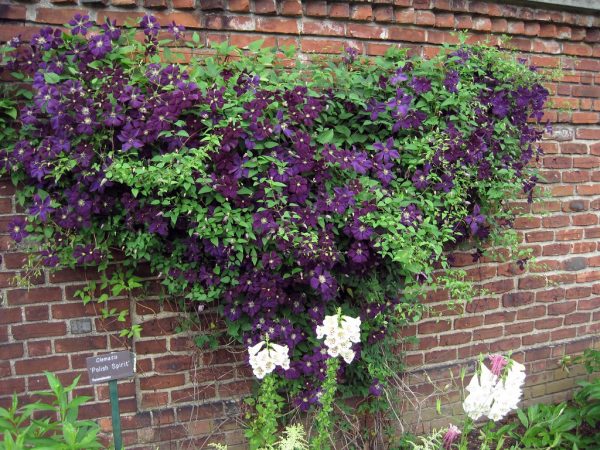
Clematis vit polish spirit
- it is planted singly near any vertical supports - pergolas, arches, fences, near the walls of houses and outbuildings;
- a liana hanging from pillars, dead tree trunks looks beautiful;
- combine with other varieties of clematis, creating a multi-colored and lush hedge;
- planted near terraces, gazebos for colorful decoration and high-quality shading at lunchtime.
Testimonials
Many gardeners have this variety in good standing due to several qualities:
- has good winter hardiness, when the necessary nutrients are added, it grows on all types of soil;
- blooms magnificently and for a long time, which allows you to enjoy beauty until autumn;
- it is combined with almost any vegetation in the garden, therefore it is used to create an original and unique composition on a personal plot.

